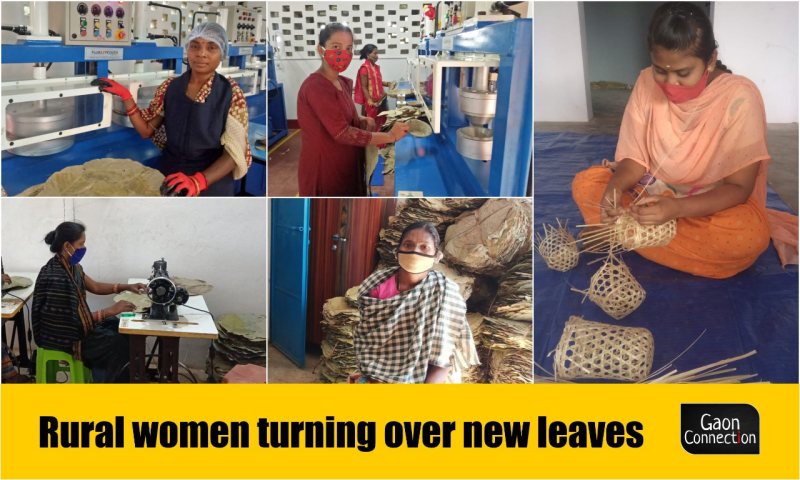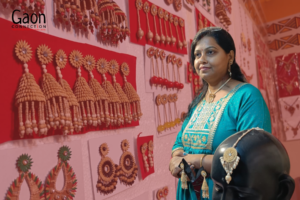At an age when most of her friends were deciding which course to enroll in colleges, 20 year-old Vijaya Kumari had to shoulder the burden of running her family of five. Having lost her parents at a young age, she chose not to continue with her education and became the sole breadwinner of the family. Initially, she used to graze cows of the local villagers which fetched her Rs 100 on a lucky day.
Last year, amid the pandemic when livelihoods shrunk, Vijaya’s uncle suggested she join the Industree Foundation’s POWER project, when the non profit’s team visited her village in Nakkundi, Karnataka as a part of their mobilisation programme.
Industree Crafts Foundation (Industree) is a non-profit organisation that runs the Producer Owned Women Enterprises (POWER) Project. The project develops enterprises creating biodegradable products with natural materials like non-timber forest products, banana bark, and bamboo. These products are hand-produced, and the processes are not machine-dependent and cannot be mass-produced using technology.
Vijaya picked up the ropes of the work quickly, learnt to make baskets, lamp-shades, and mats from bamboo. Within a year, she now heads a team of 15 rural women in Chamarajanagar district. She also earns enough to sustain her family of five sisters, and has ensured that her younger sisters don’t have to suffer the same fate as hers.
Also Read: Beekeeping gives the Santhal tribal women in Banka, Bihar, a sweet taste of success
“I am the one who opens the unit at nine in the morning, assigns work to different workers, supervises the work, and takes stock of the work being done,” Vijaya told Gaon Connection. “Initially, I was very hesitant, however with due training, I learnt how to make different products using bamboo. Now I train other women to make these products. My work has made me feel very empowered,” she added.
These bamboo products are sent to the POWER project’s main unit in Channapatna, over 100 kilometers away, from where it is marketed to different parts of the country.
Over 1,100 kilometres away, on the eastern coast of the country, rural women in Kandhamal district of Odisha are stitching eco-friendly plates and bowls from the sal and siali leaves they collect from their forests. With support from the POWER project, these leaves have become their regular source of livelihood.
The states identified for the implementation of the POWER projects are Tamil Nadu, Karnataka, and Odisha. At present there are 5,758 women currently associated with the project. Over its three year period from September 2019 to September 2022, the project aims to set up 28 women-owned enterprises.
These enterprises are expected to connect 6,800 women producers to commercial supply chains, such as IKEA in natural and biodegradable products including leaf plates, baskets, mats, and bags from tree leaves, bamboo, banana, and other natural fibers.
“These are examples of resilience and sustainability that need to grow and get replicated not only across India, but globally if we are to uplift people from poverty while safeguarding the planet,” Neelam Chhiber, the co-founder of Industree said.
She went on to inform that the initiative has helped initiate a Bamboo Resource Centre in Channapatna, Karnataka and create a platform for the very skilled bamboo Medhar community to reach global buyers and the growing conscious consumer.
Industree’s POWER initiative is supported by the United States Agency for International Development’s Women’s Economic Empowerment (USAID WEE).
Turn over a new leaf
Explaining how they source their raw materials, Nibanti Majhi, who works at the Kandhamal unit in Odisha where eco-friendly plates and bowls are stitched, said, “We collect two types of leaves from the nearby forest – sal and siali. Siali leaves are found in dense forests.” These leaves are brought to the unit, pressed and stitched together to make plates.
“Sal leaves fetch us twenty five rupees for fifty leaves whereas Siali leaves fetch us hundred rupees for hundred leaves. The reason being, Siali are bigger in size – almost 18 inches and can be stitched finely as compared to the Sal leaves,” informed Nibanti. Moreover, siali are a little difficult to procure because it’s not easy to break these leaves from the trees, she added.
The Kandhamal unit employs 380 producers. Not all of them are permanent workers, a few of them are paid to procure raw materials such as leaves from the forest and are paid per leaves. Whereas the remaining are employed to press the leaves, and stitch them together.
From the Kandhamal unit, these products are sent to the Bhubaneswar unit where the final product is made – plates and bowls of different sizes ranging from 12 inches to 8 inches and 6 inches.
While the units are located close to their villages which helps to cut down on travel time for the women, the only problem they now face is the cutting down of forests which forces them to travel five to six kilometres on foot so that they can get the raw materials.
“Earlier, we didn’t have to walk a lot but our travel time has increased because forests have been cut so we have to cover long distances to collect the leaves,” Majhi told Gaon Connection.
A taste of freedom for rural women
Rina Sethi, a woman artisan based in Panchagaon village of Khordha district, works as a machine operator in the Bhubaneswar unit. Rina shared how she was constantly criticized by her neighbours for going out of the house for work.
“When I started working, people constantly used to say that a woman ought to confine herself to the four walls of the house and not move out to work. None of that deterred me from working. The unit is barely two kilometre from the village, and I am easily able to walk to work along with my colleagues,” Rina told Gaon Connection.
Stating what motivated her to join the workforce, she said that initially she was very hesitant because she had never stepped out of her house to work, but with training and a handsome salary, her confidence grew.
“I knew that what I was doing would improve the condition of my family. In addition to that, I wanted to be independent and not rely on my husband for every penny. Now the same women who initially criticized me, want to work and earn money like I do,” Rina said, with a sense of pride in her voice.
Also Read: Self help groups in Uttar Pradesh learn to use the mobile phone as marketing tool
Financial independence and new learnings
In a similar vein, her colleague’s story is no different. Rupali Priyadarshini Patra is the only female earning member of her 13 member family. Due to financial constraints, she had to start working at the age of 19 when all her friends were currently enrolled in college.
Today, Rupali takes pride in assisting her family and is saving money for her higher education. “After saving small amounts from my salary in the initial months, I bought an android mobile for myself. I hand over my salary to my parents and am very happy that I can contribute in my own little way,” Rupali told Gaon Connection.
The best part of the job, according to Rupali, is how her newly found independence has shaped her personality and confidence. “The fact that I can operate a computer now is very empowering for me. I work as the store incharge in the Bhubaneswar unit and maintain records. I do data entry and check how many products are being made, and the quality of the products,” she explained.
Sushila Majhi, an artisan who works at the Kandhamal district, said: “Earlier we used to sell agricultural produce. Make pickles out of mango pulp, sell tamarind, mahua flowers and amla. The income was erratic and we often had to take loans to make ends meet.”
“Now I have a regular income. My husband is a daily wage labourer and is often unable to find work, but my salary helps run the household,” she added.
Reducing the carbon footprint
One of the key features of these projects under POWER is that it has reduced commuting distance for artisans.
According to an internal study done by the Industree Foundation, their conscious effort to move their base to the rural areas has helped in reducing carbon footprint. Seventy-three per cent of the artisans who work under this project stay within a radius of five kms.
The study highlighted that 51 per cent of the artisans walk to work, 16 per cent come by public transport, and 26 per cent by autorickshaws.
Earlier, the artisans had to travel a distance of 20 km to seek jobs, or migrate to bigger cities. The combined savings of 247,860 kilograms carbon dioxide (CO2) per year is equivalent to not using 105,462 liters of petrol, or not using 92,167 liters of diesel, or not burning 122,909 kg of coal, according to Industree.


















